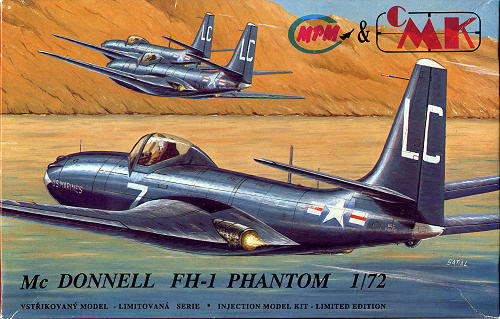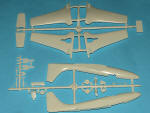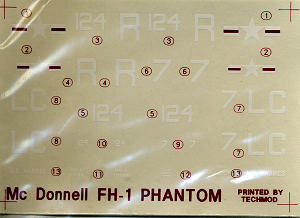
MPM & CMK 1/72 FH-1 Phantom
| KIT: | MPM & CMK 1/72 FH-1 Phantom |
| KIT #: | 005 |
| PRICE: | $15.00 when it was new |
| DECALS: | Two Options |
| REVIEWER: | Scott Van Aken |
| NOTES: | Short run of the older kind |

| HISTORY |
The McDonnell FH Phantom was a twin-engined jet fighter aircraft designed and first flown during World War II for the United States Navy. The Phantom was the first purely jet-powered aircraft to land on an American aircraft carrier and the first jet deployed by the United States Marine Corps. Although its front-line service was relatively brief, it proved the viability of carrier-based jet fighters to the leadership of the US Navy. Furthermore, it was McDonnell's first successful fighter, leading to the development of the follow-on F2H Banshee, one of the two most important naval jet fighters of the Korean War.
Production Phantoms incorporated a number of design improvements over the prototypes, including provisions for a centerline drop tank, a strengthened airframe, an improved gunsight, a modified tail, the addition of speed brakes, and slightly more powerful engines. The first Phantoms were delivered to USN fighter squadron VF-17A (later redesignated VF-171) in August 1947; the squadron received a full complement of 24 aircraft on May 29, 1948. Beginning in November 1947, Phantoms were delivered to US Marine squadron VMF-122, making it the first USMC combat squadron to deploy jets.
The Phantom's service as a front-line fighter would be short-lived. Its limited range and light armament- notably its inability to carry bombs- made it best suited for duty as a point-defense interceptor. However, its speed and rate of climb were only slightly better than existing propeller-powered fighters and fell short of other contemporary jets such as the P-80 Shooting Star, prompting concerns that the Phantom would be outmatched by future enemy jets it might soon face. Moreover, recent experience in World War II had demonstrated the value of naval fighters that could double as fighter-bombers, a capability the Phantom lacked. Finally, the plane exhibited some design deficiencies- its navigational avionics were poor, it could not accommodate newly-developed ejection seats, and the location of the machine guns atop the plane's nose caused pilots to be temporarily blinded by muzzle flash when firing the guns at night.
The USN's Phantoms were widely used for carrier qualifications. VF-17A became the USN's first operational jet carrier squadron when it deployed aboard USS Saipan on May 5, 1948. However, little combat training was ever carried out by the planes. The F2H Banshee and F9F Panther, both of which began flight tests around the time of the Phantom's entry into service, better satisfied the Navy's desire for a versatile, long-range, high-performance jet. Consequently, the Phantom was quickly declared obsolete and served most widely as a trainer for pilots whose squadrons were awaiting Panther or Banshee deliveries, starting in August 1948 when the Phantoms of VF-17A were dispersed to other units. The FH-1 was entirely withdrawn from USN and USMC service by late 1949, prior to the outbreak of the Korean War. The planes would see training duty with the USNR until 1954. No Phantom would ever see combat.
In 1964, a flight school restored 2 Phantoms to flying condition, intending to use them to teach civilians how to fly jets. The venture was unsuccessful and the planes were soon retired once again.
| THE KIT |
 This is one of MPM's first kits. Back then, and we are talking 1991/92 time frame, MPM was not the name it has grown to be. They were just learning the business and had produced a number of interesting vacuformed kits before getting involved in doing short run injected plastic.
This is one of MPM's first kits. Back then, and we are talking 1991/92 time frame, MPM was not the name it has grown to be. They were just learning the business and had produced a number of interesting vacuformed kits before getting involved in doing short run injected plastic.
There are two white sprues with large mold gates and equally large ejector towers on the inside of all the large parts. Panel detailing is finely engraved and is consistent over the long runs (not always the case with short run). Detail is what I'd consider minimal in other areas. There are no boxed in wheel wells, the cockpit consists of a floor, seat, instrument panel and control stick. There are blanking plates just a short distance in the intakes and none for the exhaust. The small parts show some flash to varying degrees, though clean up should be simple. Wings and tail planes are butt joined.  No photo etch is provided as MPM had not yet discovered this medium. Detailing for the landing gear is a bit on the soft side, though it is nice to see one piece wheels. Antennas and pitot tubes need to be made by the builder. One nicely molded vac canopy (not shown) is also included.
No photo etch is provided as MPM had not yet discovered this medium. Detailing for the landing gear is a bit on the soft side, though it is nice to see one piece wheels. Antennas and pitot tubes need to be made by the builder. One nicely molded vac canopy (not shown) is also included.
Instructions are basic, but adequate for a kit like this with minimal parts. A nice three view in 1/72 is provided to help with alignment and parts placement. A parts diagram is also shown that includes where to cut the gear doors. Construction is shown in a single exploded view. It is shown that nose weight is needed though no indication is made of how much. Markings are for two overall sea blue aircraft, one with VF-17A with the tail code of R and, as shown on the box art , the other from VMF-122 with the tail code of LC. Decals are nicely printed by Techmod.
| CONCLUSIONS |
When I built this kit back when it first came out, it provided me with little in the way of trouble. It is a basic kit, but provides ample opportunity to add in whatever detail you might like. If nothing else, I'd make a set of seat harnesses out of tape. I picked this up from a vendor's table last year and so it can still be found. Oddly, it has never been issued by anyone else so is pretty much all that is out there for this aircraft.
| REFERENCES |
August 2008
If you would like your product reviewed fairly and fairly quickly, please contact the editor or see other details in the Note to Contributors.